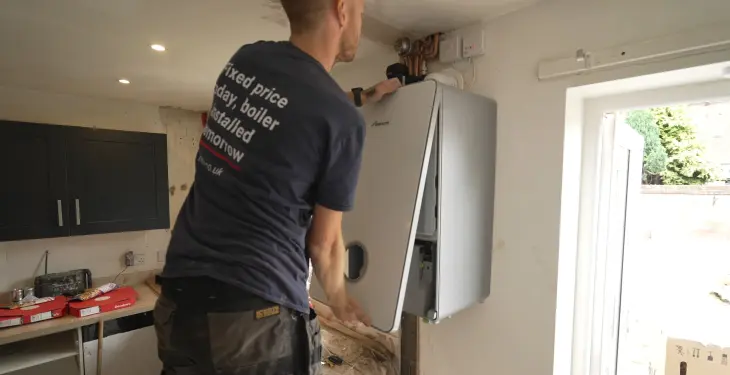

Written by Stephen Day
Gas Safe Engineer
Updated: 8th October, 2025
A Grundfos central heating pump is an essential part of a boiler system in many UK homes. Grundfos pumps are known for their reliability and efficiency, ensuring hot water circulates properly throughout the heating system.
Get a new boiler quote, save up to £550 per year (0% APR available).
In the realm of home heating systems, the Grundfos central heating pump stands out as a vital boiler component.
Its primary function is to circulate hot water from the boiler to the radiators and back, ensuring even heat distribution throughout your home.
Without the essential pump, your radiators wouldn't be able to warm up effectively, leaving you in the cold.
While its role is crucial, the Grundfos heating pump is not free from problems. Common issues can arise, including airlocks, incorrect installation, and debris build-up, which can cause the pump to become noisy or ineffective.
Proper installation and regular maintenance are key to addressing these problems and ensuring your heating system runs smoothly.
Understanding the benefits and potential issues of the Grundfos central heating pump can help you optimise its performance.
Adjusting its speed and flow settings can be a simple fix to some common problems like uneven heating. Knowing how to maintain and troubleshoot this pump will save you time and keep your home warm during the colder months
Get a quote in 60 seconds, fitted as fast as next day!
0% APR finance available.
A Grundfos central heating pump is an essential part of a boiler system in many UK homes. Grundfos pumps are known for their reliability and efficiency, ensuring hot water circulates properly throughout the central heating system.
A Grundfos central heating pump is designed to circulate hot water from the boiler to radiators and back. It operates using electricity to power a small motor inside the pump. This motor moves water through the system, maintaining the desired water pressure and temperature.
Grundfos pumps are known for their fantastic energy efficiency, which helps in reducing the overall carbon footprint of the heating system. They operate quietly and consistently, ensuring that the heating system performs at its best without unnecessary noise. The pumps also include features like automatic speed control, which adjusts the pump's speed based on the heating demand, helping to conserve energy.
Grundfos offers several types of central heating pumps, including standard and premium models. The Grundfos Alpha 3 is a popular premium model known for its advanced features and high efficiency. These pumps consist of several key components: the motor, impeller, and housing.
The motor powers the pump, while the impeller moves the water. The housing protects these components and ensures safe operation. Some models also come with advanced settings for more precise control over the heating system. For example, they might have automatic air-venting systems and temperature sensors to enhance performance.
Grundfos pumps are designed for easy installation and maintenance. This includes replaceable seals and impellers, which can help extend the pump's lifespan and maintain efficiency over time. Users in the UK often choose Grundfos for their reliability, ease of use, and energy-saving benefits.
Central heating pumps are key components in UK boiler systems. Their primary job is to move hot water from the boiler to the radiators and back. This ensures that every room in a house receives heat evenly.
These pumps are usually found near the boiler or in airing cupboards. Grundfos is one of the leading manufacturers of these pumps. Many new boilers come with Grundfos pumps as standard. This shows the brand’s reliability and efficiency in managing home heating.
A central heating pump works by using impellers. These impellers pressurise water, making it move smoothly through the system. This movement is crucial for keeping the house warm, especially during winter.
Without a working pump, the hot water would not circulate properly. This could lead to cold spots in rooms or even a complete lack of heating. Therefore, having a well-functioning pump is essential for comfortable living conditions.
Benefits of a Central Heating Pump:
Even Heat Distribution: Ensures all rooms get heated.
Energy Efficiency: Proper circulation reduces energy waste.
Compact Design: Fits easily near the boiler or in a cupboard.
Proper maintenance of the central heating pump is important. Regular checks can prevent issues like blockages or airlocks. This keeps the system running smoothly and efficiently.
In summary, central heating pumps play a vital role in the effectiveness of UK boiler systems. Their functions are crucial for providing consistent and efficient heating throughout homes.
Proper installation and initial setup of a Grundfos central heating pump are essential to ensure efficient performance. This involves selecting the correct pump size, hiring a professional for installation, and configuring the right pressure and flow settings.
Selecting the correct pump size is crucial for maintaining optimal pressure and flow within your central heating system. An under-sized pump may struggle to circulate water effectively, leading to uneven heating.
To determine the right size, consider system requirements such as:
Total heating output
Length of pipework
Number of radiators or zones
While DIY installation might be tempting, it is recommended to hire a professional. Incorrect product installation can lead to inefficiencies and increased wear.
Professionals can:
Ensure the pump is mounted securely
Align pump and pipework to prevent air locks
Verify the correct electrical connections
After installation, setting the correct pressure and flow is critical. Inadequate settings can cause noise or inefficient heating.
To adjust:
Consult the manual for recommended parameters.
Use Grundfos GO Remote for precise control.
Adjust speed settings ensuring the hot water cylinder receives proper flow.
Regular inspection is suggested to maintain these settings.
Grundfos central heating pumps offer several key benefits for homeowners. These features contribute to improved heating efficiency and reliability. They are a top choice for modern heating systems.
One of the major advantages of Grundfos pumps is their energy efficiency. With advanced technology, these pumps use less electricity, which can lead to lower energy bills. The energy-efficient design makes them an environmentally friendly option as well.
Grundfos pumps are known for their durability. Many models come with a 5-year warranty, reflecting their strong build quality. These pumps can last for many years, reducing the need for frequent replacements.
Noise levels in heating systems can be a concern. Grundfos pumps are designed to operate quietly, providing a more comfortable home environment. This is particularly beneficial for households where the pump is installed near living spaces.
Grundfos central heating pumps are relatively straightforward to install, making them a popular choice among professionals. Maintenance is also easy, ensuring that the system remains efficient with minimal effort.
By ensuring a consistent and efficient circulation of hot water, these pumps help in maintaining an even temperature throughout the home. This can enhance overall comfort during the colder months.
Many Grundfos models come equipped with advanced features like frequency converters. These features allow the pump to adjust its speed according to the heating demand, leading to better performance and efficiency.
Although Grundfos pumps come from a leading brand, they are not particularly expensive. The combination of energy savings, reliability, and low maintenance costs make them a cost-effective choice for many households.
Grundfos central heating pumps can encounter issues that affect their performance. The following sections cover common problems like leaks and airlocks, providing specific details on each issue and how to address them.
Leaks in a Grundfos central heating pump can be caused by several factors. Seal failures and cracked housing are common culprits. Leaks often manifest as water pooling around the pump or dripping from it.
To identify the source, inspect joints and seals closely. Worn seals may need replacing, and housing cracks might require a new pump. Ensure that all connections are tight and free from damage.
Fixing a leak usually involves tightening any loose fittings. If the leak persists, it might require replacing seals or the entire pump. Always ensure the power is off before attempting repairs. Using the manufacturer's installation manual can guide you through specific steps needed for your model.
Airlocks are a frequent issue. Air in the system can cause the pump to make unusual noises like knocking or clanking. This air prevents water from circulating properly.
Grundfos pumps typically have a bleed screw to release trapped air. To bleed the pump, locate this screw, turn it slowly to release air until water starts to flow out. This should resolve the airlock issue. Ensure proper sealing and tightness to prevent air from entering again.
Noisy pumps can also result from the pump shaft not being horizontal or debris causing vibration. Check the pump's positioning and clean any debris to reduce noise. Tightening the fittings and ensuring proper positioning can significantly cut down on noise and improve performance.
Using these tips can help maintain the efficiency of your Grundfos central heating pump and prevent common problems.
Proper maintenance of a Grundfos central heating pump ensures durability, energy efficiency, and fewer breakdowns. Key aspects include a regular maintenance schedule, methods to prevent blockages and airlocks, and optimizing energy-efficient operations.
Establishing a regular maintenance schedule is crucial. Basic tasks include checking the pump shaft for wear and tear, inspecting for leaks, and ensuring the bleed screw functions correctly.
The pump should also be cleaned to remove any dirt and debris that could lead to inefficiency.
Suggested Maintenance Tasks:
Monthly: Inspect for leaks and check the bleed screw.
Annually: Perform a full system check, including power flush to remove sludge from pipework.
Upon Sign of Trouble: Promptly address any unusual noises or drop in performance.
Various checks help in preventing blockages and airlocks. Dirt and debris often accumulate, potentially clogging the pump. Regular system cleaning and use of filters can be effective solutions.
Preventive Measures:
Power Flush: Conduct a power flush annually to clear debris from the system.
Filters: Install inline filters to capture dirt.
Bleed the System: Regularly use the bleed screw to release trapped air.
By maintaining these preventive actions, the longevity and efficiency of the pump can be greatly enhanced.
Grundfos pumps are known for their energy-efficient design. Maintaining this efficiency involves regular checks and following best practices.
Ensure that the pump is appropriately sized for the system, as oversizing leads to unnecessary energy consumption. Keep towel rails and radiators balanced to avoid overburdening the pump.
Energy-Saving Tips:
Optimal Sizing: Use the correct pump size.
Balance Radiators: Ensure radiators and towel rails are balanced.
Use Modern Controls: Employ smart thermostats and advanced control systems.
These steps help in achieving a sustainable and eco-friendly heating system.
Grundfos central heating pumps vary in price depending on the brand, model and key features. Some factors include speed settings, energy efficiency, and guarantees.
Not all boilers come with a Grundfos central heating pump. Grundfos pumps are very popular due to their reliability and efficiency. They can be found in many UK homes, but boilers from different manufacturers might use other brands. When replacing or upgrading, it's worth considering Grundfos for their robust performance and solid warranties.
Here are some price examples for Grundfos central heating pumps:
Grundfos UPS2 15-50/60: Around £160, with a solid 5-year warranty.
Grundfos UPS3 15-50/65 130: Approximately £157.98 excluding VAT.
Prices may vary based on the supplier and any additional features or services offered. Always compare options before making a purchase.
Without the correct adjustments and optimisation, even the best heating pumps like the Grundfos models can fail to deliver efficient performance. Key adjustments include setting the pump speed and ensuring radiators are balanced for even heat distribution.
Setting the pump speed correctly is crucial for the optimal performance of the central heating system. If the pump speed is too fast, it can cause issues such as noise and uneven heat distribution. On the other hand, if it is too slow, your radiators may not heat up properly.
Firstly, identify the type of boiler you are using, whether it is a Worcester Bosch or another brand. Adjusting the speed depends on the boiler's power and the plumbing setup.
Start by setting the pump to the lowest speed. Gradually increase the speed while monitoring the system. Check if all radiators are heating evenly and that the hot water circulates properly.
Incorrect speed settings can lead to increased energy consumption or cold radiators. Always refer to the boiler manual or consult with an engineer for specific settings tailored to older boilers or systems with wiring issues.
Balancing radiators ensures that every radiator in the system gets an equal share of hot water. This prevents some radiators from being too hot while others remain cold.
Begin by opening all radiator valves fully. This step allows hot water to flow freely.
Next, use a thermometer to measure the temperature of each radiator. Adjust the lockshield valve (usually found at the end of the radiator) to control the flow. Tighten the valves for radiators that are too hot and loosen them for colder ones.
For older boilers, make sure the balancing process is thorough since such systems might need more adjustments. Regular maintenance and checking for any wiring issues can also help maintain a balanced system, ensuring efficiency and comfort in your home.
New boilers can be a daunting purchase for many people as they’re an appliance with a lot of responsibility, providing heat for you and your family is something you want to get right. Boilers aren’t exactly a quickly disposable item either, potentially lasting you a decade.
Effectively, new boiler cost can be split into two segments: the first is the actual boiler itself (unit price), and the second is the cost of the boiler being installed (set up) in your property by an expert engineer.
Here at iHeat, we remove all of this undue stress and make the decision making process of upgrading to a new central heating system, as easy as possible.
New boiler costs can vary depending on a number of factors including their brand, model, fuel, output, warranty, labour and boiler installation type. Typically a new boiler will cost between £1,845 and £3,500, below is a list of average boiler installations offered by iHeat (guide only).
Installation Type | Price (inc VAT) | |
Combi to combi swap | £1,845 | |
System to combi conversion | £2,499 | |
New boiler install | £2,899 | |
Back boiler to a combi | £3,299 | |
System to system | £1,945 |
Last updated: 8th October, 2025

Written by Stephen Day
Gas Safe Engineer at iHeat
Stephen Day is a Gas Safe registered and FGAS certified engineer with over 20 years of hands-on experience in the heating, cooling, and renewable energy industry, specialising in boiler installations, air conditioning, and heat pump systems.
LinkedInArticles by Stephen Day are reviewed by iHeat’s technical team to ensure accuracy and reliability.

22nd December, 2025
Based on data from over 7000 boiler installations completed by iHeat in the past 12 months...
 Read Article
Read Article

22nd December, 2025
Here’s a quick roundup of the best combi boilers for 2026.
 Read Article
Read Article

22nd December, 2025
When your old boiler breaks down and it comes time to replace it with a new one, it might...
 Read Article
Read Article
No obligation. Takes less than 60 seconds.